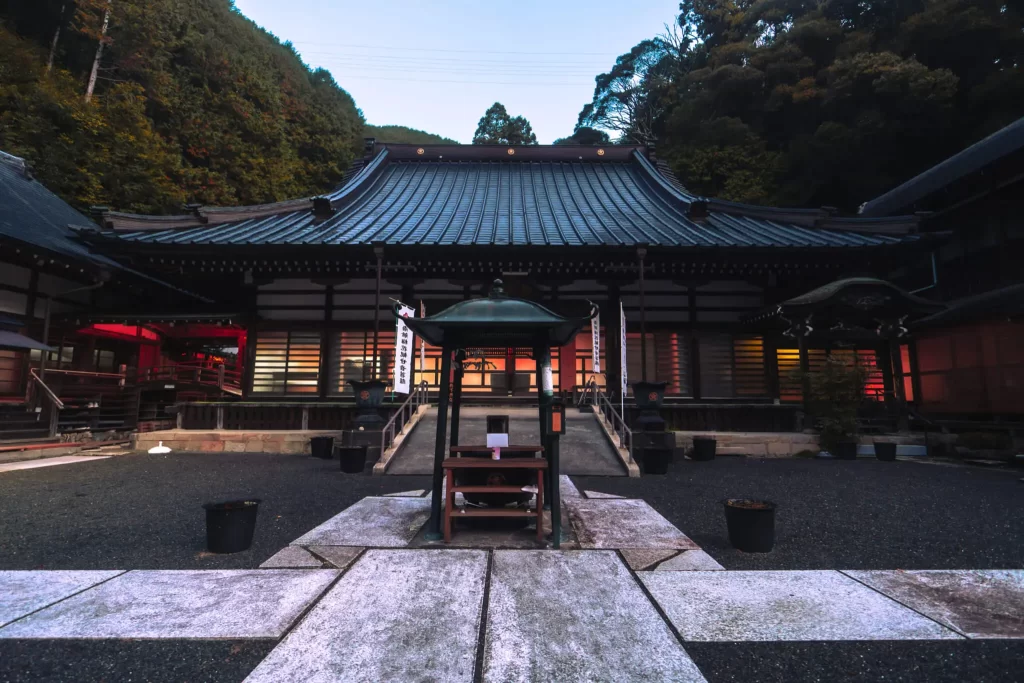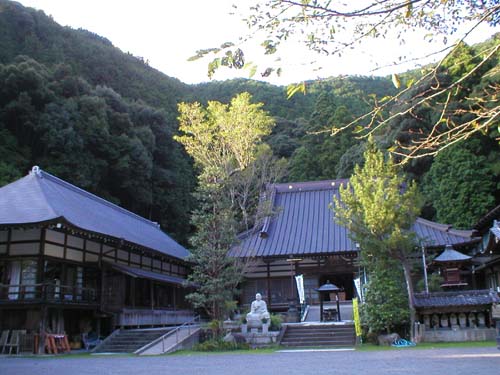Kyūjūzan Tōkei’in – A Virtual Visit

Kyūjūzan Tōkei’in is a Zen temple of the Sōtō school located near to the town of Shizuoka (180 km to the west of Tokyo) on Mt. Kuzumi. The temple was originally a Shintō sanctuary dedicated to the divinity Sumiyoshi Umanaku Daimyōjin, transformed later into a temple of Japanese Shingon (esoteric) Buddhism while bearing the name Kikei’in (alternatively, Kikei’an).
[The original French version of these words, and many of the photographs, are by Eric Rommeluère, founder of the “Un Zen Occidental” Sangha in Paris, Dharma Heir of Nishijima Roshi and Dharma Brother to Jundo.]

The Road Up The Mountain
In 1452, the governor of the province of Fukushima, Lord Iga, entrusted the direction of the temple to Zen Master Sekisô Enchû (d. 1455), who renamed it the Tôkei’in. Sekisô Enchû took the title of second abbot, leaving the honorary title of abbot-founder (jap. Kaisan) to his late Master, Jochû Tengin (1365-1440), as was often the custom at the time. Once leaving the main road up the mountain, one takes a long path lined by ceders.
Waterfalls
The temple is built in the mountains. As is typical of mountain Zen temples, waterfalls run close by.


The Dragon’s Gate
At the end of the path, it’s necessary to cross a bridge, some steps, and one then arrives in front of the main courtyard.
The bridge bears the name “the Dragons’ Gate,” pointing to a famous legend. The story concerns a section of China’s Yellow River where the current is incredibly strong. Any fish able to swim upstream against the white water is rumored to turn instantly into a dragon. So too, the student of Zen in life’s currents.


A First Glimpse…
From the top of the steps.
At The Entry…
A Stupa of Five Tiers.


The Fountain
Perhaps a Shinto influence, purifying waters are found at the entrance to many temples in Japan.
The Hall of Ususama Myōō
A hall dedicated to Ususama Myōō, an esoteric deity said to ward off evil spirits and to clean impure things, as well as to have special powers of healing, at the west of the entry, as seen from the fountain. It is not uncommon to find elements borrowed from esoteric Buddhism in Zen temples and practice in Japan.


The Hall of Jizo
The hall of Jizō is dedicated to the Bodhisattva Kshitigarbha (jap. Jizō Bosatsu), one of the most popular bodhisattva in Japan. Jizō is the source of consolation par excellence for beings, as he wanders through hell granting mercy, and is the guardian of children who have died at a young-age.
One sees him venerated everywhere, his statues cut of rough stone, with offerings of rice, flowers, child’s garments, bibs (red generally, as in the photograph), and the like to him.


Kannon
Near the entry, a statue of Kannon (Avalokiteshvara, Kannon Bosatsu), the Bodhisattva of Compassion. The temple is dedicated to Kannon with a thousand arms and a thousand eyes.
A General View
A general view of the temple, taken from near the fountain. At the center, the principal hall (jap. Hondô) which is used primarily for rituals, on the left, a general-purpose building, and on the right, barely visible, a hall (jap. Kuri) in which are joined together the kitchen, a dining room and the residences of the some of the monks.
Also not clearly distinguishable, between the main hall and the building on the left, is a sliver of the roof of the meditation hall (jap. Zendô), located behind these buildings. At the center of the picture is a statue of Kûkai (774-835), the founder of the Japanese esoteric Shingon school. Tôkei’in belonged to the Shingon school before being converted into a Zen temple in the 15th century, and the statue respects that fact.


Zendo Meditation Hall (Front)
The meditation hall contains a front room holding part of the gaitan outer platform and ritual instruments such as a bell, drum, and wooden han.
Zendo Meditation Hall (Front – Entryway)
An altar is placed at the center of the room, and on both sides platforms for meditation. The sign indicates that Zazen, “seated meditation,” is underway.


Zendo Meditation Hall (Platforms)
Tan platforms holding zafu cushions. In the foreground, kyōsaku sticks sometimes used to stimulate the drowsy.
Zendo Meditation Hall (Altar)


Zendo Meditation Hall (Rear)
Tan platforms holding zafu cushions.
Gudo Nishijima Roshi at Tokei’in


Teaching by Gudo Nishijima Roshi in the Main Hall (jap. Hondō).
The Great Bell


Gudo Nishijima Roshi
Among the tea fields (August 2003).

